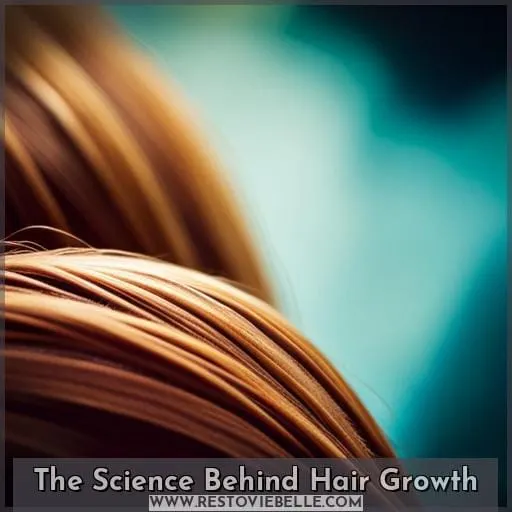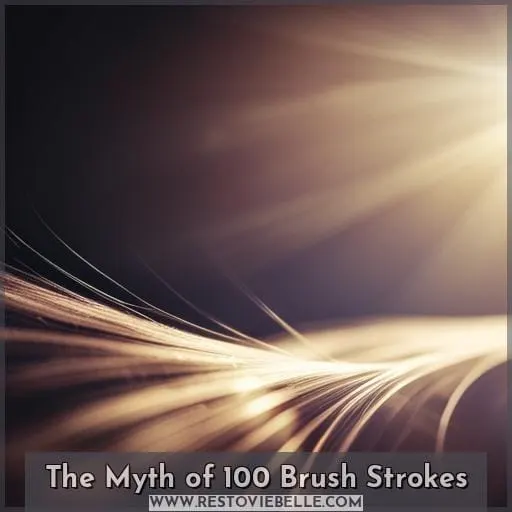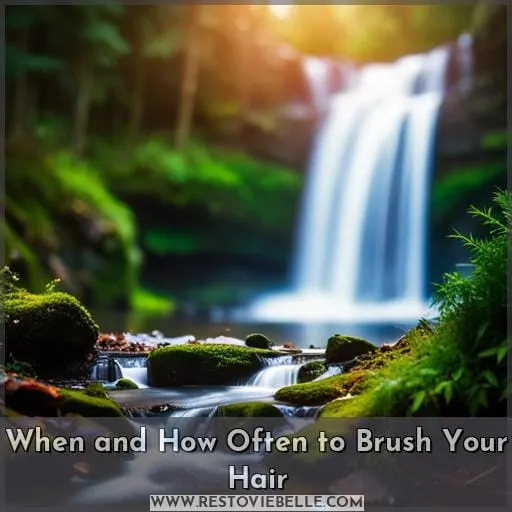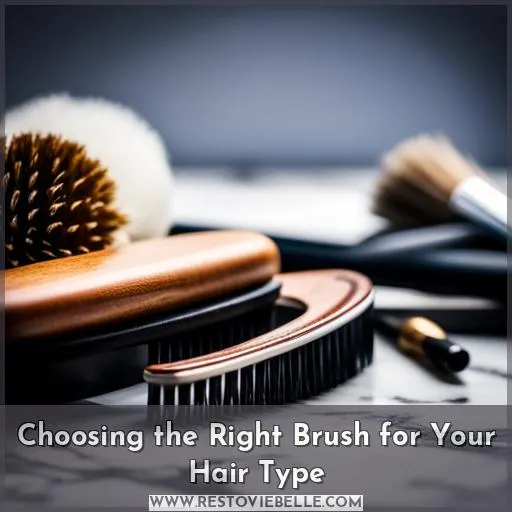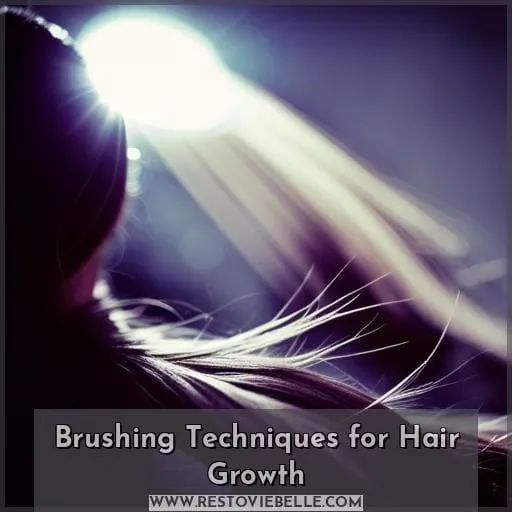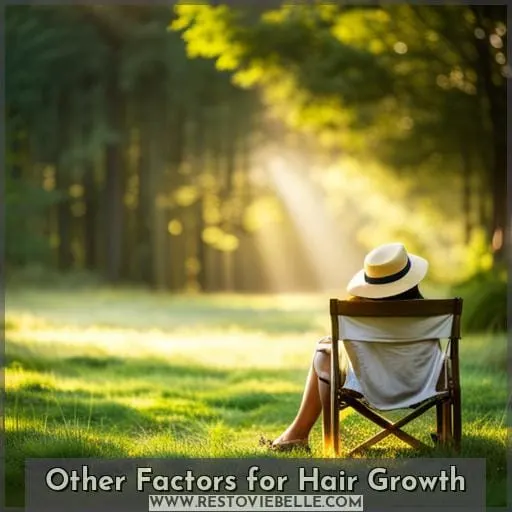This site is supported by our readers. We may earn a commission, at no cost to you, if you purchase through links.
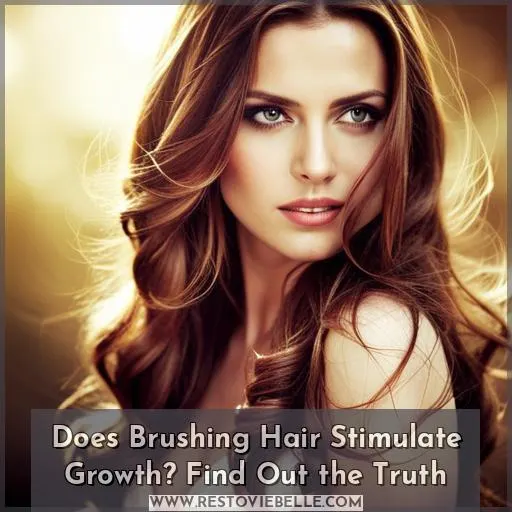 Are you curious about the truth behind whether brushing your hair can stimulate growth? Many people have heard that daily brushing is key to long, luscious locks, but does this really hold true? Could it be possible that all those strokes of the brush are a waste of time and effort?
Are you curious about the truth behind whether brushing your hair can stimulate growth? Many people have heard that daily brushing is key to long, luscious locks, but does this really hold true? Could it be possible that all those strokes of the brush are a waste of time and effort?
Let’s dive into what science has revealed about how our grooming habits impact our hair health. We know genetics play an important role in determining your natural rate of hair growth. But diet, hormones, and certain medical conditions can also affect any changes you may experience with regards to length or thickness.
So even if we determine whether bristle-stroking leads to longer strands, other factors must still be taken into consideration when assessing overall scalp healthiness.
Table Of Contents
- Key Takeaways
- The Science Behind Hair Growth
- Factors Affecting Hair Growth
- Does Brushing Hair Stimulate Growth?
- The Myth of 100 Brush Strokes
- When and How Often to Brush Your Hair
- Choosing the Right Brush for Your Hair Type
- Brushing Techniques for Hair Growth
- Other Factors for Hair Growth
- What to Do if You’re Worried About Hair Growth
- Conclusion
Key Takeaways
- Factors such as genetics, diet, hormones, and health conditions influence hair growth.
- Daily brushing stimulates the scalp and improves blood circulation.
- Choosing the right brush for your hair type is important, such as boar bristle brushes for fine hair and detangling brushes for thick hair.
- Brushing techniques, such as wet brushing for curly hair and nighttime brushing to prevent flat morning hair, can enhance circulation and reduce breakage.
The Science Behind Hair Growth
You may be surprised to learn that how you care for your hair can have an impact on its growth potential. Hair brushing techniques are important when it comes to stimulating the scalp and promoting blood circulation, which helps distribute natural oils more evenly.
Contrary to popular belief, there is no scientific evidence that suggests frequent brush strokes stimulate hair growth or add shine. In fact, excessive brushing can damage the cuticle of your strands, leading to breakage and tangles.
Selecting the right brush is key in caring for healthy tresses. Boar bristle brushes work best with fine thin hairs, while detangling brushes are great for thick locks. Quality matters too. Look out for brands like Giorgio & Kent, who offer high-quality products specifically designed with different purposes in mind, such as volumizing or smoothing effects.
Bone combs also provide a gentle massage action during styling, which increases sebum production, promoting stronger, healthier follicles over time.
Factors Affecting Hair Growth
Your hair growth is affected by a combination of genetics, diet and nutrition, hormones, and health conditions. Genetics determine how much hair you have on your head, while eating a balanced diet rich in proteins helps keep the scalp healthy for new hairs to grow.
Hormones also play an important role in regulating hair loss or gain, as well as any underlying medical condition that might be causing it.
Genetics
Genetics plays a major role in determining your hair growth, like the engine of a car that decides how fast it will go. Genetic hair loss and hereditary baldness are often causes of thinning or lack of growth.
Hair genetics determine scalp health, oil production levels, and other factors affecting hair care decisions.
Brushing can stimulate growth but won’t replace genes as the main contributor to healthy locks. Understanding your individual genetic makeup is key to unlocking long-term success with any kind of styling routine or product use.
Genetics also determines which products work best for you. Some may make certain types more susceptible to damage while others provide better stimulation for optimal results when brushing regularly.
With proper knowledge on genetics related to hair health comes true liberation: mastering one’s own personal look through understanding their unique needs!
Diet and Nutrition
Eating right nourishes your scalp and supports healthy hair. Focusing on a balanced diet with protein, vitamins, and minerals promotes growth from within. Consume omega-3s and antioxidants for nourishment. Seek vitamin infusion therapy if deficient.
Remember, there’s no quick fix or magic bullet – lifelong nutrition is key for lush locks.
Hormones and Health Conditions
Daily stress can mess with your hormones, throwing your locks out of whack. Hormonal imbalance and medical conditions like thyroid disease can stunt hair growth. But nothing a little stress management, supplements, and TLC from your doctor can’t help.
Brushing helps shine, but for fuller follicles, you have to nourish your whole self.
Does Brushing Hair Stimulate Growth?
Keeping your hair healthy does require paying attention to proper hair care techniques. Brushing your hair the right way actually provides multiple beneficial effects that help promote hair growth and overall health.
Benefits of Proper Hair Brushing
Massaging your scalp daily helps boost circulation for stronger, healthier locks.
- Stimulates blood flow to follicles
- Distributes natural oils
- Reduces breakage
- Exfoliates dead skin cells
- Improves texture and shine
Proper brushing, along with supplements like biotin or collagen, can help nourish follicles. Choosing the right brush for your hair type reduces tangles and damage for healthy growth.
The Role of Brushing in Blood Circulation
Brushing your locks helps increase blood flow to the scalp, promoting healthier hair growth. Gently massaging your scalp with a brush boosts circulation, delivering nutrients to each strand. This stimulates the follicles, energizing dormant roots to grow faster. You can experiment with techniques like wet brushing or using supplements to maximize circulation.
Consistent, gentle brushing nourishes your mane by improving blood flow. Varying your brushing technique, pressure, and direction nourishes different areas, ensuring thorough circulation. Aim for at least 100 strokes when brushing. Be patient and gentle, avoiding damage from harsh brushing.
Scalp massages performed while brushing increase stimulation. Using natural boar bristle or mixed bristle brushes optimizes circulation benefits. Brushing removes dead skin cells and spreads nourishing oils along the hair shaft.
Proper brushing improves shine, minimizes breakage, and keeps your locks healthy.
Hair Brushing and Natural Oils Distribution
Your locks lap up those natural oils as you comb through with care. Bristle brushes effectively distribute natural oils from scalp to strands, nourishing hair, lessening frizz and static, and boosting shine.
Curly hair types see special perks: Wet brushing with quality bristles smoothes strands, breaks fewer hairs, and enhances curl formation.
The Myth of 100 Brush Strokes
To debunk a common hair care myth, let’s explore why the notion of brushing your hair a hundred times daily might not be the key to lush locks.
The idea of achieving hair growth through 100 brush strokes is a persistent myth that has circulated for decades. However, in reality, this excessive brushing may do more harm than good. Hair growth is primarily determined by the health of your hair follicles and your overall well-being, not by the number of brush strokes.
In fact, excessive brushing can lead to damage, especially if you’re using the wrong brush or technique.
To promote hair growth, it’s more important to focus on gentle and proper brushing techniques, using the right brush for your hair type. Additionally, consider incorporating hair growth supplements, maintaining a healthy diet, and using sulfur-free shampoos to support your hair’s overall health.
When and How Often to Brush Your Hair
Frequent, gentle strokes of the right brush can be like a soothing massage for your scalp.
But when it comes to stimulating hair growth, it’s important to clarify a few points. While brushing won’t magically make your hair grow like a weed, it does play a role in maintaining a healthy scalp, which is crucial for optimal hair growth.
Here are four key aspects to consider:
-
Wet Brushing: Brushing when your hair is wet can be beneficial, especially for those with curly hair. It reduces breakage and helps distribute natural oils from your scalp down the length of your strands.
-
Nighttime Brushing: A few gentle strokes before bedtime can help distribute oils, preventing flat morning hair. It’s a simple step in your routine that can make a big difference.
-
Gentle Detangling: When detangling your hair, use the right brush or comb, and be gentle. Rough handling can lead to breakage, which counters the goal of healthy hair.
-
Curly Hair Care: Curly hair folks can benefit from wet brushing and using detangling brushes when needed, as this minimizes damage and tangles.
So, remember that brushing your hair contributes to overall hair health, which can indirectly support growth. It’s all about finding the right balance and techniques for your unique hair type and needs.
Choosing the Right Brush for Your Hair Type
To ensure you’re providing your hair with the best care possible, it’s essential to choose the right brush that suits your specific hair type and needs. Boar bristle brushes are an excellent choice for those with fine hair, while detangling brushes work wonders for those with thick, easily tangled hair.
Selecting the appropriate brush is a crucial step in your hair care routine, impacting how your hair looks, feels, and behaves.
Boar Bristle for Fine Hair
For fine hair, consider boar bristle brushes as they are ideal for gently caring for delicate strands. Boar bristles are excellent for fine hair care due to their ability to distribute natural oils evenly, minimizing breakage, enhancing shine, and encouraging hair health.
Pair them with high-quality hair growth supplements for optimal results. When it comes to brushing techniques, use gentle, slow strokes to prevent hair breakage and promote growth.
Detangling Brushes for Thick Hair
Choose a detangling brush specifically designed for thick, easily tangled hair to effortlessly manage your unruly locks and keep them looking their best.
-
Start from the Tips: Work your way up from the ends to the roots, gently releasing knots to minimize breakage.
-
Use Conditioner: Apply a good conditioner to make the detangling process smoother and reduce friction.
-
Wide Toothed Comb: Opt for brushes with wide-spaced bristles to prevent tugging on thick hair.
-
Detangle When Wet: Thick hair benefits from detangling while wet, as it’s more pliable and less prone to damage.
-
Be Patient: Take your time, and don’t rush through the process; patience is key to maintaining hair health.
Choosing the Right Brush
When it comes to finding the ideal brush for your unique hair type, it’s like picking the perfect tool for a specific job; you want one that matches your needs and gets the job done right. Different hair textures demand various bristle materials and brush types. If you have long, curly hair, consider a brush with plastic bristles for detangling.
Proper hair brushing, especially when dealing with wet hair, requires the right tool to prevent breakage and maintain hair health.
Brushing Techniques for Hair Growth
To promote healthy hair growth, it is essential to use proper brushing techniques. Brushing your hair correctly can improve circulation, evenly distribute natural oils, and reduce breakage, all of which contribute to the overall health and appearance of your hair.
Gentle Brushing to Avoid Damage
Achieving healthier and longer locks becomes easier when you practice gentle care with the right tools. When it comes to brushing techniques for hair growth, remember that gentleness is key.
- Use a wide-toothed comb or a paddle brush with ball-tipped, plastic bristles.
- Brush your hair when it’s dry or slightly damp.
- Start at the tips and work your way up to the roots, detangling gently.
- Brush with patience, avoiding excessive force to prevent breakage and stimulate natural oil distribution.
Gentle brushing can help you maintain hair health and support growth.
Brushing Wet or Dry Hair
For healthier-looking locks, remember that brushing your wet locks can be especially beneficial for preventing tangles and breakage, such as when individuals with curly hair carefully detangle their damp strands before styling.
Wet vs. Dry Brushing has its merits, but it’s important to consider your hair type and its specific needs. Additionally, supplements and shampoo choices can significantly impact your hair’s health and growth.
Here’s a helpful guide to wet vs. dry brushing and its impact on different hair types:
| Hair Type | Wet Brushing Benefits | Dry Brushing Benefits |
|---|---|---|
| Curly Hair | Reduces breakage and aids detangling | Reduces frizz and distributes natural oils |
| Straight Hair | Helps distribute oils evenly | Provides instant shine and smoothness |
| Thick Hair | Prevents knots and tangles | Adds volume and reduces oiliness |
Remember to choose the right brush and hair care products for your hair type, and consider supplementing your hair restoration journey with suitable vitamins and minerals. Be mindful of shampoo ingredients like sulfur, and explore reputable brush brands for optimal results.
Avoiding Excessive Brushing
Gently caring for your locks is essential to prevent unintended damage and maintain the health of your precious strands. When it comes to brushing techniques, avoiding excessive brushing is key. Over-brushing can lead to hair cuticle damage, breakage, and even hair loss.
To ensure healthy hair, it’s vital to select the right brush for your hair type and length and incorporate other healthy hair habits, such as using the right shampoo and addressing dandruff.
Other Factors for Hair Growth
To promote healthy hair growth, it’s essential to extend your focus beyond mere brushing and consider other crucial aspects of your hair care routine. Maintaining a diligent hygiene regimen, effectively managing stress, incorporating the right nutritional supplements, and following a balanced diet all play pivotal roles in the pursuit of luscious, vibrant locks.
Hair Care Routine and Hygiene
Maintaining a healthy hair care routine and good hygiene is like tending to a thriving garden; it requires regular attention and nourishment to keep it at its best.
Proper brushing techniques, the right brush selection, scalp health maintenance, and oily hair solutions are key components of an effective regimen.
Choosing between natural bristle or plastic bristles should be based on your individual needs, while wet-brushing with laser combs can help reduce breakage in curly hair types.
To master proper hygiene habits for optimal results, consider using products enriched with silicones and oils.
With these tips combined, you will have beautiful tresses that are sure to turn heads!
Stress Management
To help your locks flourish, managing stress is crucial; high levels can impact hair health. A balanced diet and nutrition are essential to promote growth: a good connection between nutrient intake and scalp condition should be maintained.
Medical conditions like alopecia areata or traction alopecia might cause loss, so consult with a doctor if concerned about it.
Nutritional Supplements and Diet
Nourishing your body with a balanced diet rich in essential vitamins and minerals, along with the right supplements, can provide the building blocks your locks need to thrive. Your dietary choices play a significant role in the health of your hair. Incorporate foods such as leafy greens, eggs, and fatty fish for essential nutrients.
Additionally, supplements like biotin, zinc, and omega-3 fatty acids can have a substantial nutritional impact, promoting healthy hair growth. Tailoring your dietary habits and reaping the benefits of these supplements is a powerful step toward hair mastery.
What to Do if You’re Worried About Hair Growth
If you’re concerned about your hair growth, there are several proactive steps you can take. First, consider scheduling a consultation with a dermatologist who specializes in hair health. They can provide expert guidance tailored to your specific needs. Additionally, explore hair growth treatments and products that are backed by scientific research and proven to be effective.
Lastly, don’t underestimate the importance of making lifestyle changes that promote optimal hair health, such as maintaining a balanced diet and managing stress levels. Taking these steps can help you address your hair growth concerns with confidence and informed choices.
Consultation With a Dermatologist
If you’re concerned about the progress of your hair, consulting a dermatologist may not be as daunting as it seems.
- Dermatologist Consultation: Schedule an appointment with a dermatologist to assess the root causes of your hair concerns.
- Hair Growth Treatments: Discuss potential treatments, such as minoxidil or low-level laser therapy.
- Lifestyle Changes: Explore adjustments to your daily routine that can promote hair health.
- Nutritional Supplements and Hair Growth Products: Your dermatologist can recommend supplements and products to support hair growth.
Hair Growth Treatments and Products
When concerned about the strength of your locks, it’s essential to explore various treatments and products that can invigorate your hair. Hair growth treatments, such as Minoxidil, have shown promise in promoting hair regrowth.
Additionally, product recommendations include shampoos with biotin and caffeine for revitalizing your scalp. Don’t fall for hair growth myths; instead, rely on science-backed options. Natural remedies like rosemary oil may also support hair health.
Lifestyle Changes for Optimal Hair Health
To optimize the health of your hair, consider making lifestyle changes that focus on your overall well-being, as it directly impacts the condition of your locks. Start with scalp massages to increase blood flow and stimulate hair follicles. Next, pay attention to your diet, ensuring it’s rich in nutrients like vitamins and protein.
Stress reduction is vital as it can contribute to hair loss. Stay hydrated as well and establish consistent hair care rituals to nurture your locks.
Conclusion
To sum it up, you may have heard the myth that brushing your hair 100 times a day can miraculously stimulate hair growth. Well, the truth is, it’s just that – a myth. Brushing your hair, when done correctly, offers several benefits like reducing breakage and promoting healthy hair.
However, it won’t make your hair sprout like a Chia Pet. Hair growth is primarily determined by factors like genetics, diet, hormones, and overall health. So, while brushing is essential for hair care, don’t rely on it alone to stimulate growth.

